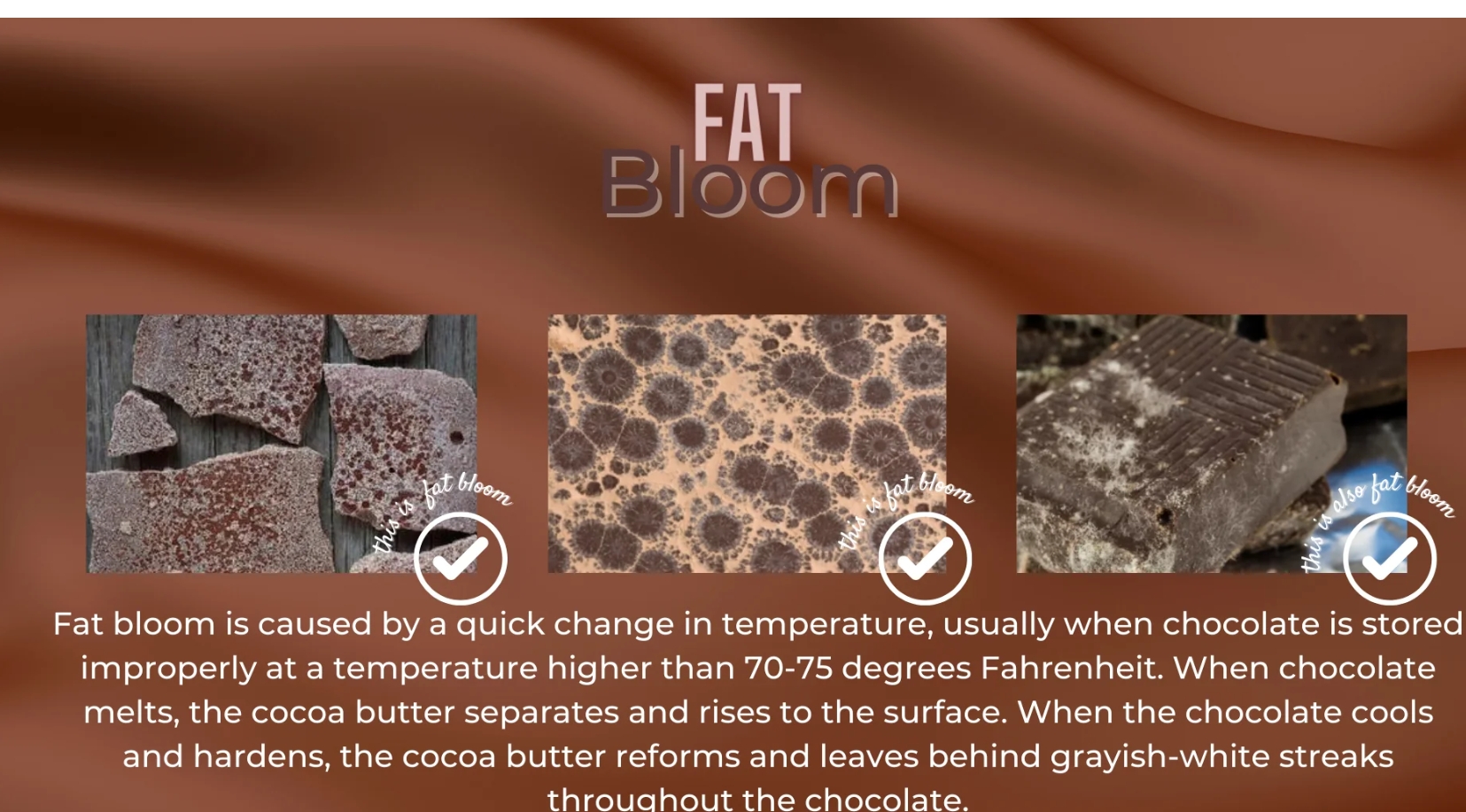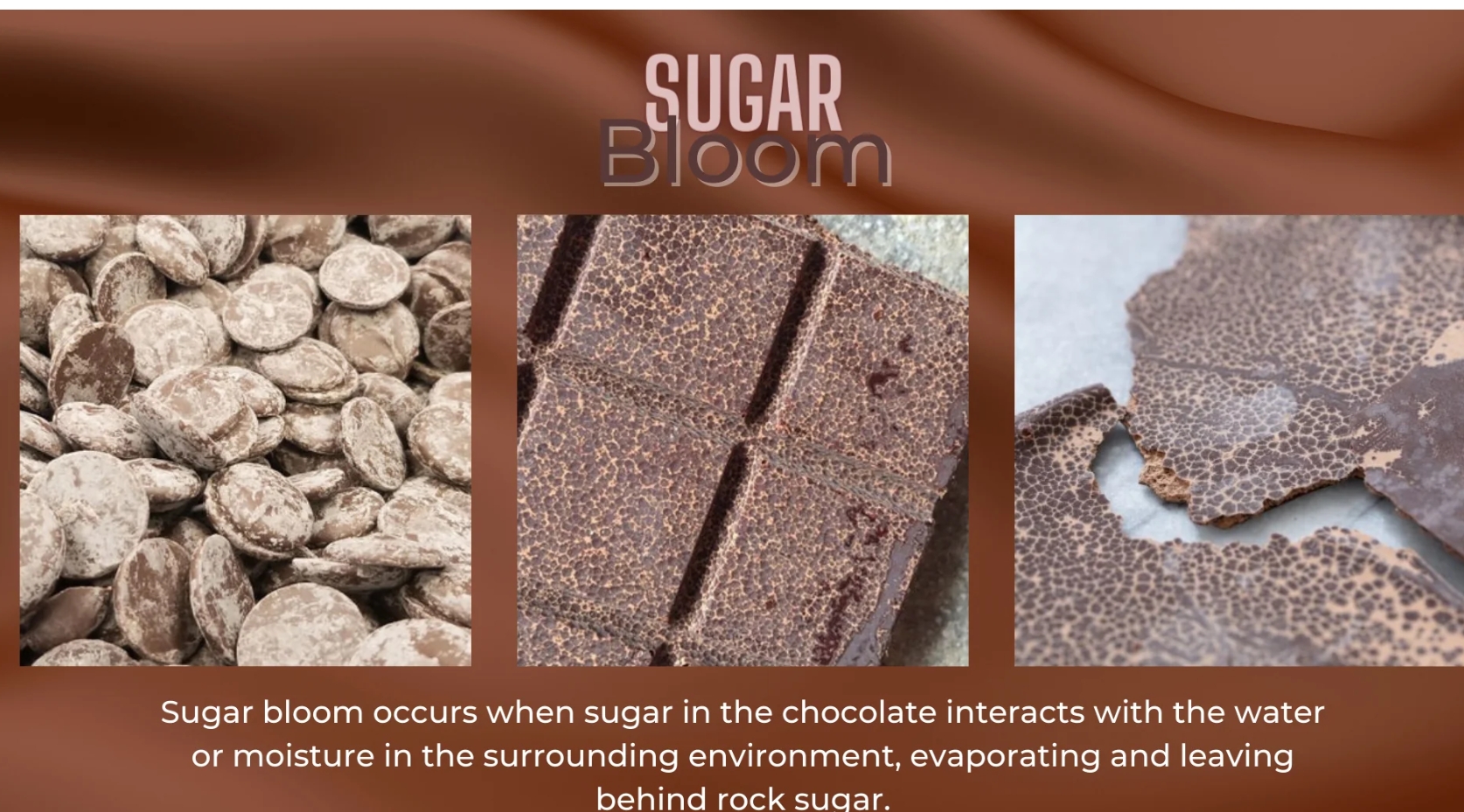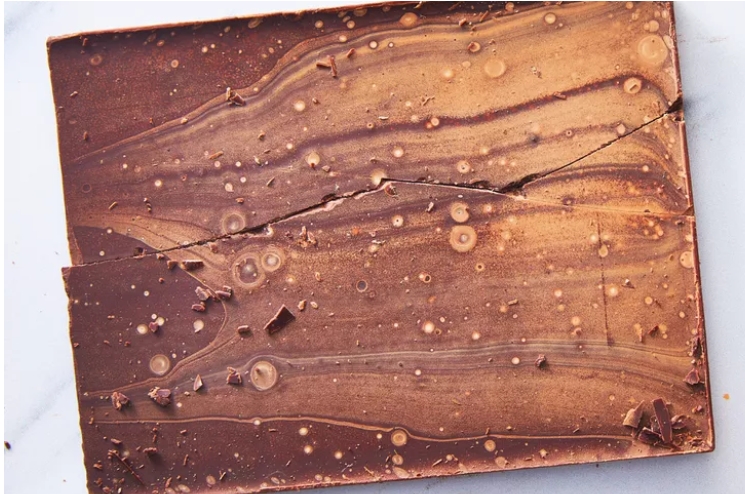Chocolate, with its glossy surface and smooth texture is a beloved treat worldwide. But if you’ve ever opened a chocolate bar only to find white or gray streaks on the surface, you’ve encountered a phenomenon known as chocolate bloom. While it may look unappetizing, chocolate bloom is a common and largely harmless issue. Still, it affects not only the appearance but also the texture and sometimes the taste of chocolate.
In this blog post, we’ll take a deep dive into chocolate bloom — what it is, the science behind it, how to prevent it and whether bloomed chocolate is still safe to eat.
WHAT IS CHOCOLATE BLOOM?
Chocolate bloom is a visible defect that appears as a whitish coating or streaking on the surface of chocolate. There are two main types of chocolate bloom:
1. FAT BLOOM
Fat bloom occurs when the fat (cocoa butter) in the chocolate separates from the cocoa solids and migrates to the surface. This usually results in a grayish-white film or streaks. It’s more common in milk and white chocolate due to their higher fat content.
CAUSES OF FAT BLOOM
Improper storage temperatures: Storing chocolate in warm environments, especially above 24°C, causes cocoa butter to melt and then re-solidify unevenly.
Poor tempering: If chocolate hasn’t been properly tempered (a process that stabilizes cocoa butter crystals), it can lead to unstable crystal formations that cause bloom.
Filling migration: Chocolates with fatty fillings (like peanut butter or ganache) can cause fat to migrate through the shell and bloom on the surface.

2. SUGAR BLOOM
Sugar bloom happens when moisture comes into contact with the chocolate. The water dissolves the sugar in the chocolate, and as the moisture evaporates, it leaves behind rough, sugary crystals on the surface. This typically feels grainier than fat bloom and appears as dry white spots.
CAUSES OF SUGAR BLOOM
Condensation: Moving chocolate from a cold to a warm, humid environment can lead to condensation on the surface, dissolving the sugar.
High humidity: Even without drastic temperature changes, high humidity alone can introduce moisture to chocolate.
Refrigeration: While it might seem like a safe storage option, the fridge can cause condensation during transitions in and out of cold environments.

HOW TO IDENTIFY THE TYPE OF BLOOM
APPEARANCE
FAT BLOOM : Dull gray or white streaks
SUGAR BLOOM : Dry, dusty or blotchy white spots
TEXTURE
FAT BLOOM : Smooth or slightly soft
SUGAR BLOOM: Rough and gritty surface
REACTION TO TOUCH
FAT BLOOM : Smudges with finger heat
SUGAR BLOOM : Does not melt or smudge easily
TASTE
FAT BLOOM : Oily or waxy
SUGAR BLOOM : Grainy or overly sweet
IS BLOOMED CHOCOLATE SAFE TO EAT?
Yes, bloomed chocolate is safe to eat. It may not taste or feel as smooth as fresh chocolate, but it’s not spoiled. However, if the chocolate has an off smell, sour taste or mold (which is rare), it should be discarded.
HOW TO PREVENT CHOCOLATE BLOOM
1. PROPER STORAGE
- Temperature: Store chocolate at a consistent, cool temperature—ideally around 13–20°C.
- Humidity: Keep chocolate in a dry place with humidity below 50%.
- Avoid temperature swings: Don’t move chocolate quickly between cold and warm environments.
2. AVOID REFRIGERATION (If Possible)
Refrigeration is a common cause of sugar bloom. If you must refrigerate:
- Wrap chocolate tightly in plastic or an airtight container.
- Place the container in a sealed bag with a desiccant (like silica gel) to absorb moisture.
- When removing from the fridge, let it come to room temperature before unwrapping to avoid condensation.
3. TEMPERING
For home bakers and chocolatiers, tempering is crucial. Proper tempering ensures stable cocoa butter crystals, which prevents fat bloom.
The tempering process involves carefully heating, cooling and reheating chocolate to precise temperatures depending on the chocolate type.
4. SEAL WELL
Use airtight containers to store chocolate, especially in humid climates.
For commercial chocolate, vacuum sealing or nitrogen-flushed packaging can prevent moisture intrusion.

CAN YOU FIX CHOCOLATE BLOOM
If bloom has occurred, especially fat bloom, you can melt and re-temper the chocolate to restore its appearance and texture. Sugar bloom is more difficult to fix because it affects the sugar structure. For bloomed chocolate you’re not using as decoration or gifts, consider using it in recipes where appearance doesn’t matter—like brownies, cookies or hot chocolate.
FINAL THOUGHTS
Chocolate bloom is an unwelcome surprise, but it doesn’t mean your chocolate is bad. Understanding the causes, whether fat or sugar bloom can help you store and handle chocolate more effectively. Whether you’re a casual chocolate lover or an aspiring chocolatier, proper care can keep your chocolate shiny, smooth and delicious.
So next time you see a white haze on your chocolate, don’t panic, it’s just a little science at work.

 Hello. I'm Shivesh Bhatia, a food blogger and food stylist from Delhi, India. Welcome to Bake With Shivesh, where I'll help you create magic in your kitchens with my simple recipes.
Hello. I'm Shivesh Bhatia, a food blogger and food stylist from Delhi, India. Welcome to Bake With Shivesh, where I'll help you create magic in your kitchens with my simple recipes.
Leave a Reply